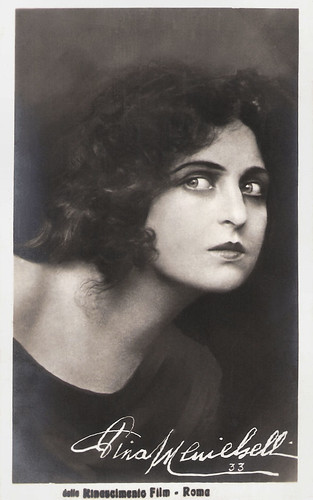
Italian postcard by La Rotofotografia, no. 33. Photo: Rinoscimento Film.

Italian postcard by Fotocelere, Torino, no. 44.
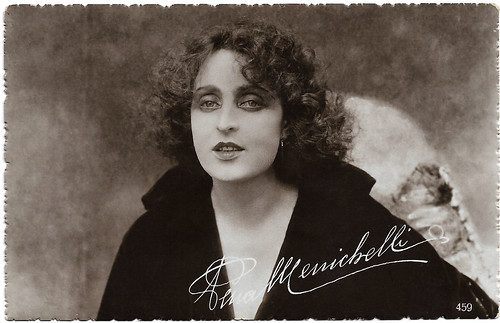
Italian postcard by Ed. A. Traldi, Milano, no. 459.

Italian postcard by Ed. A. Traldi, Milano, no. 719.

French postcard in the Les Vedettes du Cinéma series by Editions Filma, no. 7. Photo: Super-Film.
La trilogia di Dorina (1918)

Spanish collectors card by Chocolate Imperiale, no. 1 of 9. Photo: Itala Film / Distr. J. Verdaguer, Barcelona. Pina Menichelli in La trilogia di Dorina Gero Zambuto, 1918), based on the eponymous play by Gerolamo Rovetta.

Spanish collectors card by Chocolate Imperiale, no. 2 of 9. Photo: Itala Film / Distr. J. Verdaguer, Barcelona. Alberto Nepoti and Pina Menichelli in La trilogia di Dorina Gero Zambuto, 1918), based on the eponymous play by Gerolamo Rovetta.
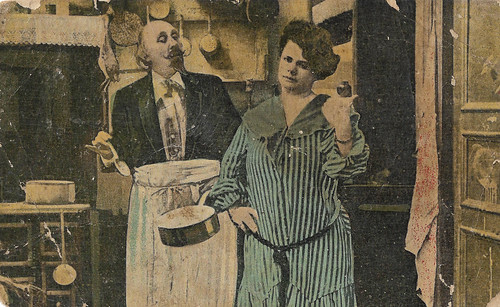
Spanish collectors card by Chocolate Imperiale, no. 3 of 9. Photo: Itala Film / Distr. J. Verdaguer, Barcelona. Scene from La trilogia di Dorina Gero Zambuto, 1918), based on the eponymous play by Gerolamo Rovetta. Probably this card depicts Dorina's parents, a once bourgeois couple that hit poverty. Unknown is who the actors are. It could also represent the moment Dorina is kicked out of the house of the marchioness. The woman depicted is not Mary-Cléo Tarlarini, who plays the marchioness.
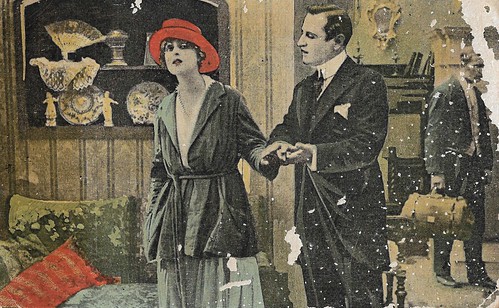
Spanish collectors card by Chocolate Imperiale, no. 4 of 9. Photo: Itala Film / Distr. J. Verdaguer, Barcelona. Pina Menichelli in La trilogia di Dorina (Gero Zambuto, 1918). The man could be the musician/choir leader (Gabriel Moreau) who helps her and discovers she is a talented singer.
Because of the sad economical conditions of her parents, the well-bred Dorina (Pina Menichelli) is forced to work as a private teacher with an austere marchioness (Mary-Cléo Tarlarini). She falls in love with the marchioness' son Niccolò (Alberto Nepoti), but the mother, afraid of marriage below her status, chases the girl. Welcomed by a musician (Gabriel Moreau) who discovers she has a beautiful voice, she receives an offer from an impresario (Antonio Monti), on condition she becomes his mistress. Offended, she refuses.
Accompanied by an older friend, don Luigi D'Albano (Vittorio Rossi-Pianelli), Niccolò, who has become rich, offers her money if she comes and lives with him. Even if still in love with him, she refuses the offer. D'Albano, profiting from the young man's loss, offers her his protection, becomes her friend, and launches her as an artist. Once she has become famous, Dorina enjoys the applause of the theatre audiences and the homages of all her admirers. Among them is Niccolò, now really in love with her. And Dorina, for whom success has not gone to her head, is now happy to accept the true love that Niccolò offers.
La trilogia di Dorina/The Dorina Trilogy (Gero Zambuto, 1918) was scripted by Giovanni Pastrone, who previously had launched Menichelli as the star in Il fuoco/The Fire (Giovanni Pastrone, 1915) and Tigre reale/The Royal Tigress (Giovanni Pastrone, 1916). In the latter film, Alberto Nepoti had already been her co-actor. Giovanni Tomatis and Segundo De Chomon were hired to care of the cinematography. The film had its premiere in Rome on 13 April 1918.
While Il fuoco had been a milestone, the press was disappointed about La trilogia di Dorina, hoping for more, but also expecting something closer to the original play. The role of Dorina, one critic wrote, was unfit for Menichelli, whose exuberance was so different from the part. While the male actors expressed elegance, their performance was considered rather on the heavy side.
Also, the mise-en-scene looked as if the film was made in too great haste, hoping for a fast reprise of the success of the previous two films with Menichelli. Perhaps the hand of Pastrone as director was missed. Still, this was what the press wrote at the time. Once this now-lost film will show up again, we may judge with our own eyes. Until then, we only have these images.
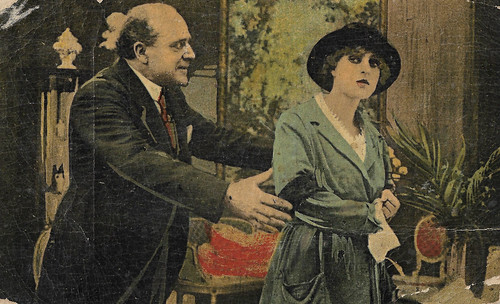
Spanish collectors card by Chocolate Imperiale, no. 5 of 9. Photo: Itala Film / Distr. J. Verdaguer, Barcelona. Pina Menichelli in La trilogia di Dorina (Gero Zambuto, 1918). The man may be Antonio Monti, who plays the impresario.

Spanish collectors card by Chocolate Imperiale, no. 8 of 9. Photo: Itala Film / Distr. J. Verdaguer, Barcelona. Pina Menichelli in La trilogia di Dorina Gero Zambuto, 1918).

Spanish collectors card by Chocolate Imperiale, no. 9 of 9. Photo: Itala Film / Distr. J. Verdaguer, Barcelona. Pina Menichelli, Alberto Nepoti and Vittorio Rossi-Pianelli in La trilogia di Dorina (Gero Zambuto, 1918).
La passeggera (1918)

Spanish collectors card by Chocolate Imperiale, no. 2 of 9. Photo: Itala Film / Distr. J. Verdaguer, Barcelona. Pina Menichelli in La passeggera/The Passenger (Gero Zambuto, 1918), released in Spain as La pasajera, and based on a story 'La passagère' by Mme Guy de Chantepleure.

Spanish collectors card by Chocolate Pi, no. 3 of 9. Photo: Itala Film / Distr. J. Verdaguer, Barcelona. Pina Menichelli in La passeggera/The Passenger (Gero Zambuto, 1918), released in Spain as La pasajera, and based on a story 'La passagère' by Mme Guy de Chantepleure.

Spanish collectors card by Chocolate Imperiale, no. 4 of 9. Photo: Itala Film / Distr. J. Verdaguer, Barcelona. Pina Menichelli in La passeggiera aka La passagera (Gero Zambuto, 1918), released in Spain as La pasajera, and based on a story 'La passagère' by Mme Guy de Chantepleure.
The beautiful, sheltered, and somewhat naïve Lucía/Lucie Boijoli/Boisjoli (Pina Menichelli) has been adopted by the millionaire Davrancai, a woman (a man, according to other sources) who spares no expense on her behalf and treats her like a princess. But Davrancai is attacked and dies. It was her stated desire to make Lucía her heir, and she was preparing to legalise this, but the paperwork was not yet in place.
Her fortune, therefore, passes to a distant cousin, Laura Arguin — a bitter but devout woman — who is unwilling to take Lucía in. Primary among Lucía’s court of admirers is the cynical fortune-hunter Fabricio de Mauve (Luciano Molinari), who drops her in order to marry the daughter of a millionaire industrialist. Desperate, Lucía eventually turns to Guillermo Kerjean (Alberto Nepoti), a friend who is a mechanical engineer in charge of the Petain aviation company. As he is only thirty years old, she cannot live with him without arousing suspicion and gossip, but she hits upon a solution: they will enter a marriage of convenience.
Kerjean has spoken of how he does not wish to marry because it will interrupt his life of engineering productivity, Lucía will never love another man after the disappointment of Fabricio de Mauve: they can kill two birds with one stone and live together as affectionate companions. At first unconvinced, Kerjean comes around to the idea, and soon the strange marriage is formalised. Humour ensues as they have to prove their fake marriage, but eventually, real love grows between the pair.
Kerjean’s engineering work has gone very well, and proud of his accomplishments, he decides that he will fly the machine himself, accompanied by a passenger, “to demonstrate the stability and capacity of the device for long voyages”. When the launch is imminent, the mechanic who was to be the passenger does not come to the airfield because of a sudden illness, and so Lucía, even knowing the risk, decides to accompany her husband and become … la passeggiera. She will “participate in his Victory or die with him”. Their love acknowledged, Lucía and Kerjean will soar together on the wings of the powerful biplane.
While the story of La passagera/The Passenger (Gero Zambuto, 1918) was not very original, audiences and the press loved the performance of the two main actors. Only a short fragment of the film survives, alas, preserved by the Filmoteca de Catalunya.

Spanish collectors card by Chocolate Pi, no. 5 of 9. Photo: Itala Film / Distr. J. Verdaguer, Barcelona. Pina Menichelli in La passeggera/The Passenger (Gero Zambuto, 1918), released in Spain as La pasajera.

Spanish collectors card by Chocolate Pi, no. 6 of 9. Photo: Itala Film / Distr. J. Verdaguer, Barcelona. Pina Menichelli and possibly Luciano Molinari in La passeggera/The Passenger (Gero Zambuto, 1918), released in Spain as La pasajera.

Spanish collectors card by Chocolate Pi, no. 9 of 9. Photo: Itala Film / Distr. J. Verdaguer, Barcelona. Pina Menichelli in La passeggera/The Passenger (Gero Zambuto, 1918), released in Spain as La pasajera.
Gemma di Sant'Eremo (1918)
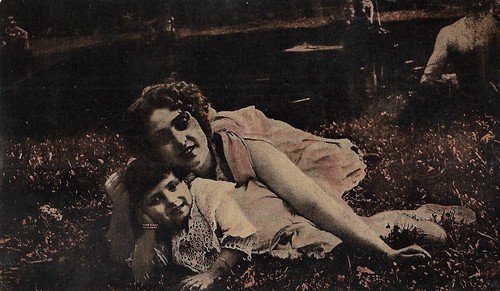
Spanish collectors card by Chocolate Salas-Sabadell, Barcelona, no. 1 of 6. Photo: Itala Film. Pina Menichelli in Gemma di Sant'Eremo (Alfredo Robert, 1918), released in Spain as La culpa (The Guilt).
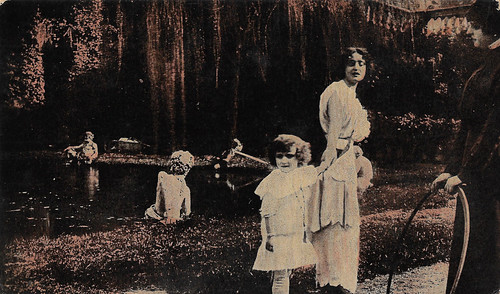
Spanish collectors card by Chocolate Salas-Sabadell, Barcelona, no. 3 of 6. Photo: Itala Film. Pina Menichelli in Gemma di Sant'Eremo (Alfredo Robert, 1918), released in Spain as La culpa (The Guilt).
Countess Gemma di Sant'Eremo (Pina Menichelli) is married to a frivolous and womanizing husband (Gabriel Moreau) and sees her marriage crumbling on the day she understands the cheating and lies of her man. A truly honest woman, Gemma does not want to avenge herself with the same arms, but destiny surprises her in a compromising conversation with marquis De Renzis (Alberto Nepoti).
To avoid a scandal, marquis De Renzis lets himself be accused of an attempt at robbery. Gemma is locked up by her husband in a castle but manages to escape. A tragic end to the husband makes an end to Gemma's suffering and opens up a reunion with her lover.
Gemma di Sant'Eremo/The Gem of St. Hermitage (Alfredo Robert, 1918) was praised in the Italian press and drew bourgeois crowds to the cinema, while also abroad, in Spain, France and Latin America. The film premiered in Rome on 4 February 1918. Only a fragment of the film has resurfaced and has been preserved by the Museo Nazionale del Cinema.

Spanish collectors card by Chocolate Salas-Sabadell, Barcelona, no. 4 of 6. Photo: Itala Film. Pina Menichelli in Gemma di Sant'Eremo (Alfredo Robert, 1918), released in Spain as La culpa (The Guilt). The man may be Gabriel Moreau, who plays Pina's husband, according to Vittorio Martinelli. Other sources say the husband is played by Edouard Davesnes.

Spanish collectors card by Chocolate Salas-Sabadell, Barcelona, no. 6 of 6. Photo: Itala Film. Pina Menichelli and Alberto Nepoti in Gemma di Sant'Eremo (Alfredo Robert, 1918), released in Spain as La culpa (The Guilt).
Una sventatella (1918)
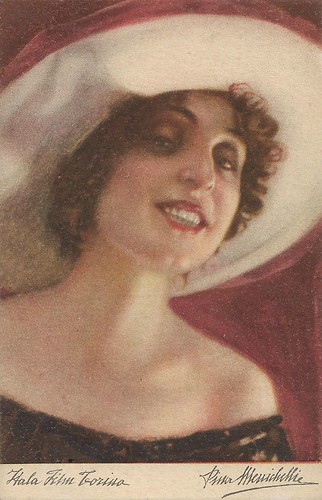
Italian postcard by Officina C. Ricordi, Milano"/ Uff. Rev. Stampa, Milano, 27-6-[19]17, no. 1325. Photo: Itala Film, Torino. Caption: "Da lunedi'7 Gennaio al Salone Ghersi, Pina Menichelli interprete di Una Sventatella." (From Monday, January 7th at the cinema Ghersi Pina Menicheli in Una Sventatella/A guttersnipe).
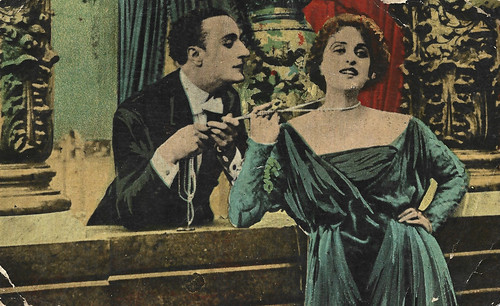
Spanish collectors card by Chocolate Imperiale, no. 3 of 6. Photo: Itala Film / Distr. J. Verdaguer, Barcelona. Pina Menichelli in Una sventatella (Gero Zambuto, 1918). The Spanish title was La pequeña atolondrada.
The cinema Ghersi was a cinema in Turin, Via Roma 40, inaugurated on 7 December 1915. The architect was Carlo Angelo Ceresa. The cinema could hold 2000 people. In 1935 the cinema was torn down to make room for the 'straightening' of the street.
Una sventatella/A guttersnipe (Gero Zambuto, 1918) was one of Pina Menichelli's last films for Itala Film in Turin, after which she started to act at Rinascimento Film in Rome, her own company.
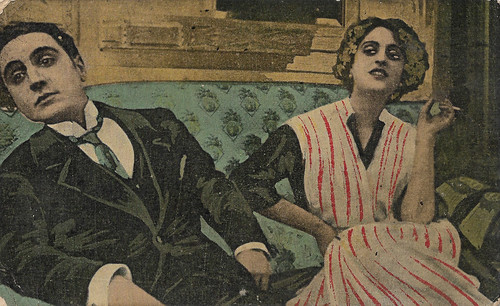
Spanish collectors card by Chocolate Imperiale, no. 4 of 6. Photo: Itala Film / Distr. J. Verdaguer, Barcelona. Pina Menichelli in Una sventatella (Gero Zambuto, 1918).

Spanish collectors card by Chocolate Imperiale, no. 5 of 6. Photo: Itala Film / Distr. J. Verdaguer, Barcelona. Pina Menichelli in Una sventatella (Gero Zambuto, 1918).
Il giardino incantato (1918)
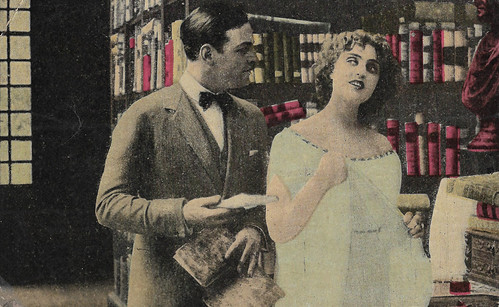
Spanish collectors card by Chocolate Imperiale, no. 1 of 6. Phot: Rinascimento Film / Distr. J. Verdaguer, Barcelona. Pina Menichelli and Luigi Serventi in Il giardino incantato (Eugenio Perego, 1918). The film was originally entitled Il giardino della voluttà, a title which the Spanish cards on the film kept, but which became forbidden by the Italian censor.

Spanish collectors card by Chocolate Imperiale, no. 4 of 6. Phot: Rinascimento Film / Distr. J. Verdaguer, Barcelona. Pina Menichelli in Il giardino incantato (Eugenio Perego, 1918).
Despite the opposition of her rich aunt Malvina (Elvira Pasquali), young Lilian Deruta (Pina Menichelli) marries the writer Giuliano Morris (Luigi Serventi), a detached and rather superficial man. Their life seems apparently happy, but fractures start to appear, as the aunt has cut her niece's allowance.
Used to a life of luxury, Giuliano commits a misstep by forgery. Liana by all means tries to help him. She goes to one of her former lovers, Lorenzo (Enrico Scatizzi), who promises to help provided she'll come to him. The sacrifice of the poor woman proves to have been in vain, as Giuliano, out of remorse, already has taken his own life.
The press praised Menichelli's restrained acting, after her exaggerated performances in previous films. Probably this was her first film at her own company Rinascimento Film, after her films at Itala Film. Critics only complained about the overload of the presence of the star.
Il giardino incantato//The Stronger Sex (Eugenio Perego, 1918) had its Roman premiere on 1 October 1918. The sets were by Charles Doudelet, and the cinematography was by Antonio Cufaro. A fragment of the film was saved by the Cineteca di Milano.
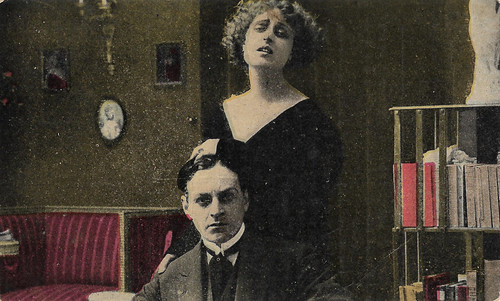
Spanish collectors card by Chocolate Imperiale, no. 5 of 6. Phot: Rinascimento Film / Distr. J. Verdaguer, Barcelona. Pina Menichelli and Luigi Serventi in Il giardino incantato/The Stronger Sex (Eugenio Perego, 1918).

Spanish collectors card by Chocolate Imperiale, no. 6 of 6. Phot: Rinascimento Film / Distr. J. Verdaguer, Barcelona. Pina Menichelli in Il giardino incantato/The Stronger Sex (Eugenio Perego, 1918).
Source: Vittorio Martinelli (Il cinema muto italiano, Vol. 1918), and Sempre in penombra.
No comments:
Post a Comment